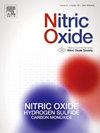Hydrogen sulfide mechanism of action in plants; from interaction with regulatory molecules to persulfidation of proteins
IF 3.2
2区 生物学
Q2 BIOCHEMISTRY & MOLECULAR BIOLOGY
引用次数: 0
Abstract
Hydrogen sulfide (H2S), previously known as a toxic gas, is currently considered one of the most important gaseous transmitters in plants. This novel signaling molecule has been determined to play notable roles in plant growth, development, and maturation. In addition, pharmacological and genetic evidence indicated that this regulatory molecule effectively ameliorates various plant stress conditions. H2S is involved in these processes by changing gene expression, enzyme activities, and metabolite concentrations. During its regulatory function, H2S interacts with other signaling pathways such as hydrogen peroxide (H2O2), nitric oxide (NO), Ca2+, carbon monoxide (CO), phosphatidic acid (PA), phytohormones, etc. The H2S mechanism of action may depend on the persulfidation post-translational modification (PTM), which attacks the cysteine (Cys) residues on the target proteins and changes their structure and activities. This review summarized H2S biosynthesis pathways, its role in sulfide state, and its donors in plant biology. We also discuss recent progress in the research on the interactions of H2S with other signaling molecules, as well as the role of persulfidation in modulating various plant reactions.
硫化氢在植物中的作用机制;从与调节分子的相互作用到蛋白质的过硫化。
硫化氢(H2S)以前被认为是一种有毒气体,目前被认为是植物中最重要的气体传递物之一。这种新的信号分子在植物生长、发育和成熟过程中起着重要的作用。此外,药理和遗传学证据表明,该调控分子能有效改善各种植物胁迫条件。H2S通过改变基因表达、酶活性和代谢物浓度参与这些过程。在调控过程中,H2S与过氧化氢(H2O2)、一氧化氮(NO)、Ca2+、一氧化碳(CO)、磷脂酸(PA)、植物激素等信号通路相互作用。H2S的作用机制可能依赖于过硫化翻译后修饰(PTM),它攻击靶蛋白上的半胱氨酸(Cys)残基并改变其结构和活性。本文综述了硫化氢的生物合成途径、硫化氢在植物生物学中的作用及其供体。我们还讨论了H2S与其他信号分子相互作用的最新研究进展,以及过硫化在调节各种植物反应中的作用。
本文章由计算机程序翻译,如有差异,请以英文原文为准。
求助全文
约1分钟内获得全文
求助全文
来源期刊

Nitric oxide : biology and chemistry
生物-生化与分子生物学
CiteScore
7.50
自引率
7.70%
发文量
74
审稿时长
52 days
期刊介绍:
Nitric Oxide includes original research, methodology papers and reviews relating to nitric oxide and other gasotransmitters such as hydrogen sulfide and carbon monoxide. Special emphasis is placed on the biological chemistry, physiology, pharmacology, enzymology and pathological significance of these molecules in human health and disease. The journal also accepts manuscripts relating to plant and microbial studies involving these molecules.
 求助内容:
求助内容: 应助结果提醒方式:
应助结果提醒方式:


